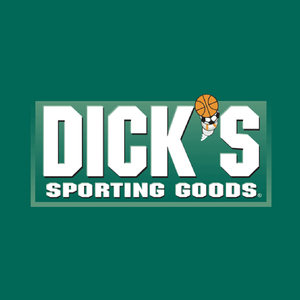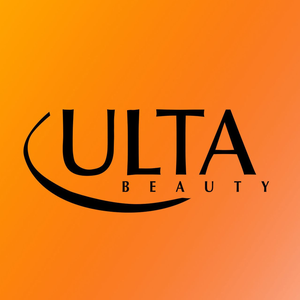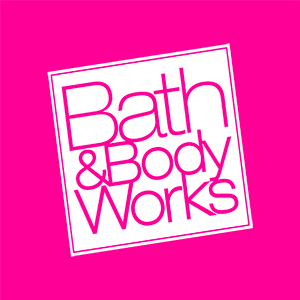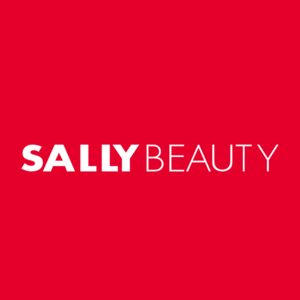
Sally Beauty (SBH)
We wouldn’t recommend Sally Beauty. Not only are its sales cratering but also its low returns on capital suggest it struggles to generate profits.― StockStory Analyst Team
1. News
2. Summary
Why We Think Sally Beauty Will Underperform
Catering to both everyday consumers as well as salon professionals, Sally Beauty (NYSE:SBH) is a retailer that sells salon-quality beauty products such as makeup and haircare products.
- Smaller revenue base of $3.70 billion means it hasn’t achieved the economies of scale that some industry juggernauts enjoy
- Dearth of new stores suggests management is prioritizing the optimization of its existing locations over growth
- Anticipated sales growth of 1% for the next year implies demand will be shaky


Sally Beauty’s quality is inadequate. There are more promising prospects in the market.
Why There Are Better Opportunities Than Sally Beauty
High Quality
Investable
Underperform
Why There Are Better Opportunities Than Sally Beauty
Sally Beauty is trading at $15.16 per share, or 7.3x forward P/E. This is a cheap valuation multiple, but for good reason. You get what you pay for.
Our advice is to pay up for elite businesses whose advantages are tailwinds to earnings growth. Don’t get sucked into lower-quality businesses just because they seem like bargains. These mediocre businesses often never achieve a higher multiple as hoped, a phenomenon known as a “value trap”.
3. Sally Beauty (SBH) Research Report: Q3 CY2025 Update
Beauty supply retailer Sally Beauty (NYSE:SBH) announced better-than-expected revenue in Q3 CY2025, with sales up 1.3% year on year to $947.1 million. The company expects the full year’s revenue to be around $3.74 billion, close to analysts’ estimates. Its non-GAAP profit of $0.55 per share was 16% above analysts’ consensus estimates.
Sally Beauty (SBH) Q3 CY2025 Highlights:
- Revenue: $947.1 million vs analyst estimates of $931.8 million (1.3% year-on-year growth, 1.6% beat)
- Adjusted EPS: $0.55 vs analyst estimates of $0.47 (16% beat)
- Adjusted EBITDA: $117.4 million vs analyst estimates of $110.1 million (12.4% margin, 6.6% beat)
- Adjusted EPS guidance for the upcoming financial year 2026 is $2.05 at the midpoint, beating analyst estimates by 1.8%
- Operating Margin: 8.4%, in line with the same quarter last year
- Free Cash Flow Margin: 8.2%, similar to the same quarter last year
- Locations: 4,422 at quarter end, down from 4,460 in the same quarter last year
- Same-Store Sales rose 1.3% year on year, in line with the same quarter last year
- Market Capitalization: $1.45 billion
Company Overview
Catering to both everyday consumers as well as salon professionals, Sally Beauty (NYSE:SBH) is a retailer that sells salon-quality beauty products such as makeup and haircare products.
With regards to the merchandise selection, the company has a strong focus on hair color, hair care, skin care, and nail products. Brands such as Wella, Clairol Professional, and Conair can be found in stores. A Sally Beauty store tends to be small, roughly 2,500 square feet, and located in urban and suburban shopping centers. The company also has an e-commerce platform, launched in 1999, that supplements its brick and mortar operations.
The company operates two banners: Sally Beauty Supply and Beauty Systems Group. Sally Beauty Supply serves the everyday consumer while Beauty Systems serves the salon professional and requires certain credentials and identification to enter. Beauty Systems burnishes the company’s reputation, showing the everyday consumer that Sally Beauty products are used in salons, while Sally Beauty Supply addresses the much larger market of consumer beauty aficionados.
The core customer of Sally Beauty Supply is typically a woman between 18 and 35 years old who considers herself a beauty enthusiast. She has specific preferences with regards to her beauty products and desires more professional-grade offerings which may not be available in the average department store or general merchandise retailer.
4. Beauty and Cosmetics Retailer
Beauty and cosmetics retailers understand that beauty is in the eye of the beholder, but a little lipstick, nail polish, and glowing skin also help the cause. These stores—which mostly cater to consumers but can also garner the attention of salon pros—aim to be a one-stop personal care and beauty products shop with many brands across many categories. E-commerce is changing how consumers buy cosmetics, so these retailers are constantly evolving to meet the customer where and how they want to shop.
Retailers specializing in beauty products include Ulta Beauty (NASDAQ:ULTA) and Bath & Body Works while department stores such as Kohl’s (NYSE:KSS) and Macy’s (NYSE:M) typically feature large cosmetics and fragrance sections.
5. Revenue Growth
A company’s long-term sales performance is one signal of its overall quality. Any business can experience short-term success, but top-performing ones enjoy sustained growth for years.
With $3.70 billion in revenue over the past 12 months, Sally Beauty is a small retailer, which sometimes brings disadvantages compared to larger competitors benefiting from economies of scale and negotiating leverage with suppliers.
As you can see below, Sally Beauty struggled to increase demand as its $3.70 billion of sales for the trailing 12 months was close to its revenue six years ago (we compare to 2019 to normalize for COVID-19 impacts). This was mainly because it didn’t open many new stores.
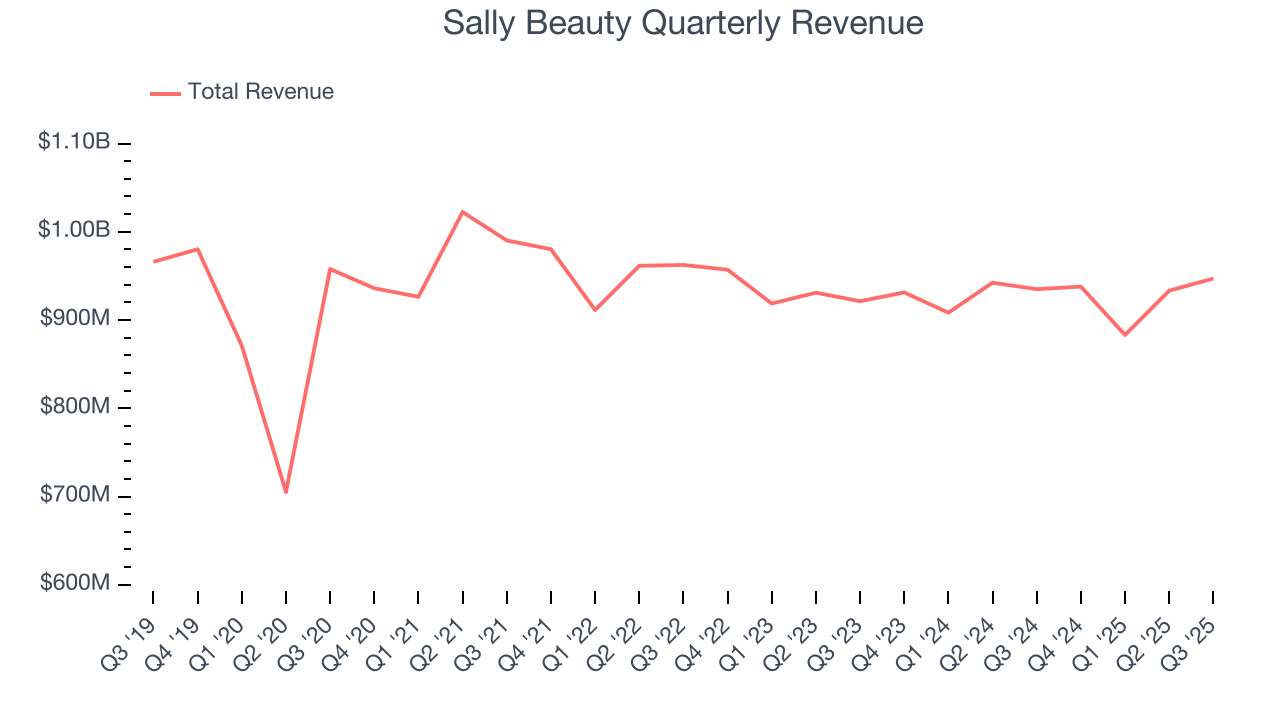
This quarter, Sally Beauty reported modest year-on-year revenue growth of 1.3% but beat Wall Street’s estimates by 1.6%.
Looking ahead, sell-side analysts expect revenue to remain flat over the next 12 months. While this projection indicates its newer products will spur better top-line performance, it is still below average for the sector.
6. Store Performance
Number of Stores
Sally Beauty listed 4,422 locations in the latest quarter and has kept its store count flat over the last two years while other consumer retail businesses have opted for growth.
When a retailer keeps its store footprint steady, it usually means demand is stable and it’s focusing on operational efficiency to increase profitability.
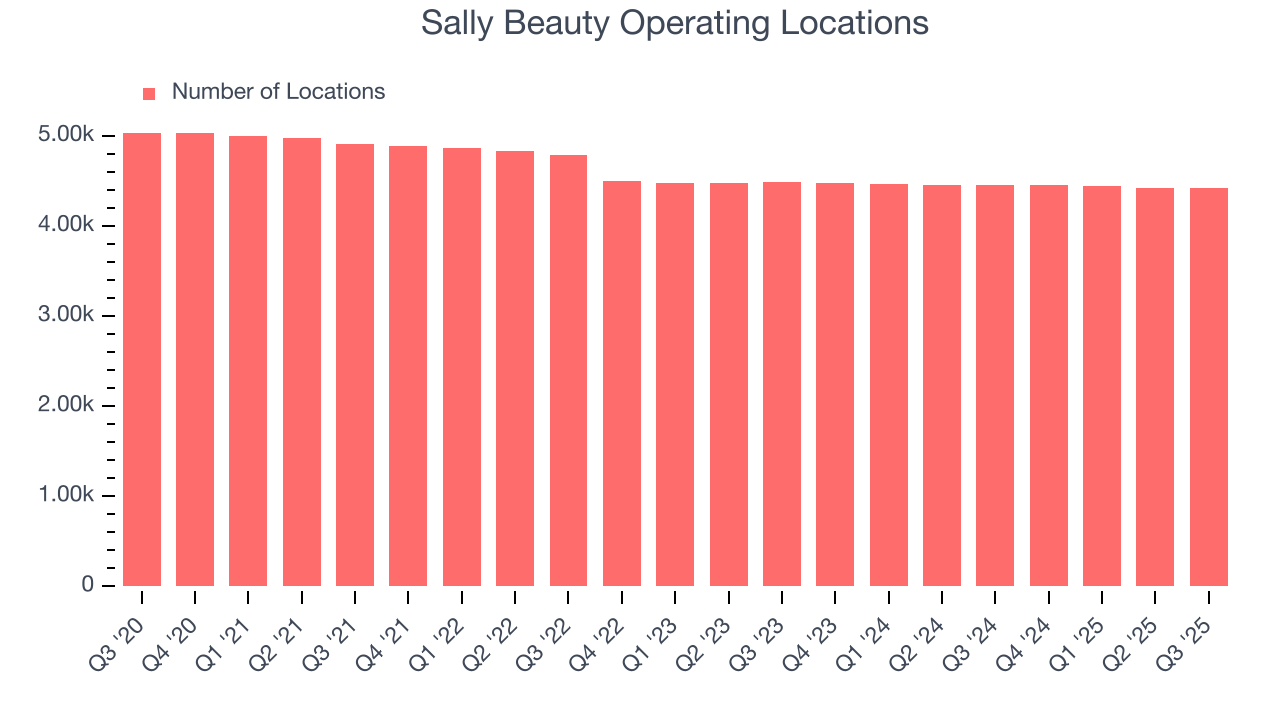
Same-Store Sales
A company's store base only paints one part of the picture. When demand is high, it makes sense to open more. But when demand is low, it’s prudent to close some locations and use the money in other ways. Same-store sales provides a deeper understanding of this issue because it measures organic growth at brick-and-mortar shops for at least a year.
Sally Beauty’s demand within its existing locations has barely increased over the last two years as its same-store sales were flat. This performance isn’t ideal, and we’d be skeptical if Sally Beauty starts opening new stores to artificially boost revenue growth.
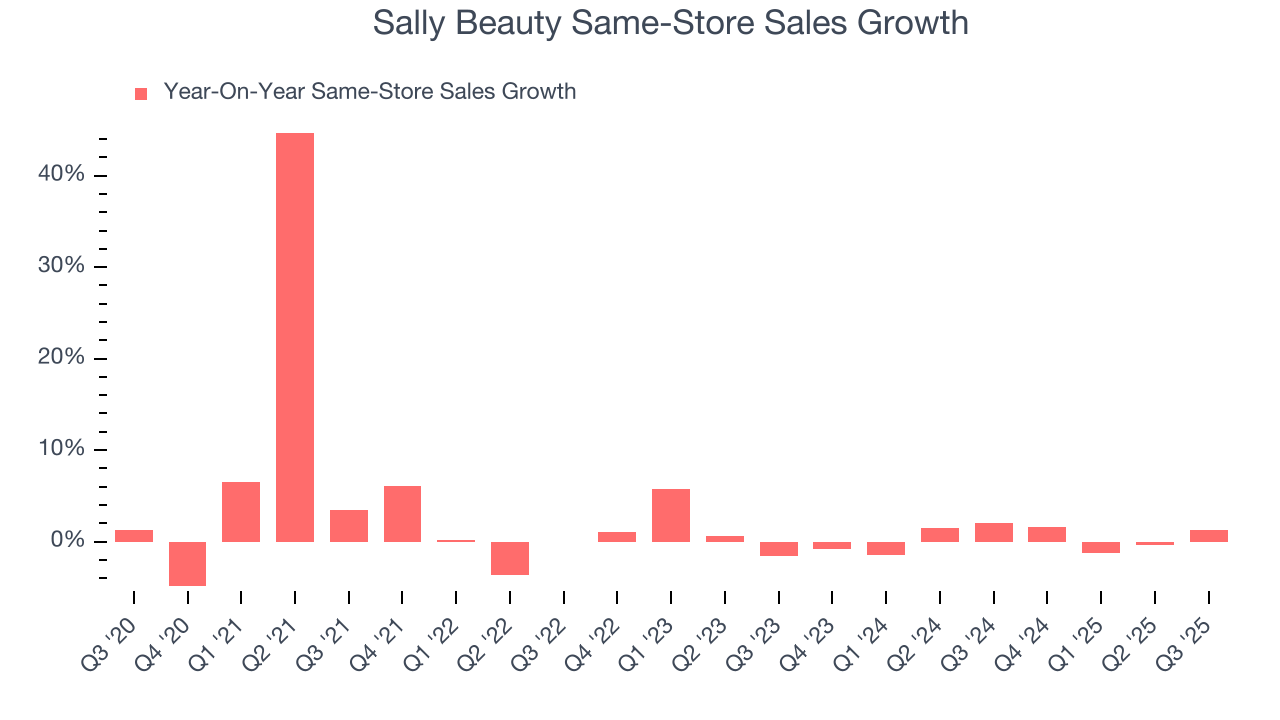
In the latest quarter, Sally Beauty’s same-store sales rose 1.3% year on year. This performance was more or less in line with its historical levels.
7. Gross Margin & Pricing Power
At StockStory, we prefer high gross margin businesses because they indicate pricing power or differentiated products, giving the company a chance to generate higher operating profits.
Sally Beauty has best-in-class unit economics for a retailer, enabling it to invest in areas such as marketing and talent to grow its brand. As you can see below, it averaged an elite 51.2% gross margin over the last two years. That means Sally Beauty only paid its suppliers $48.76 for every $100 in revenue. 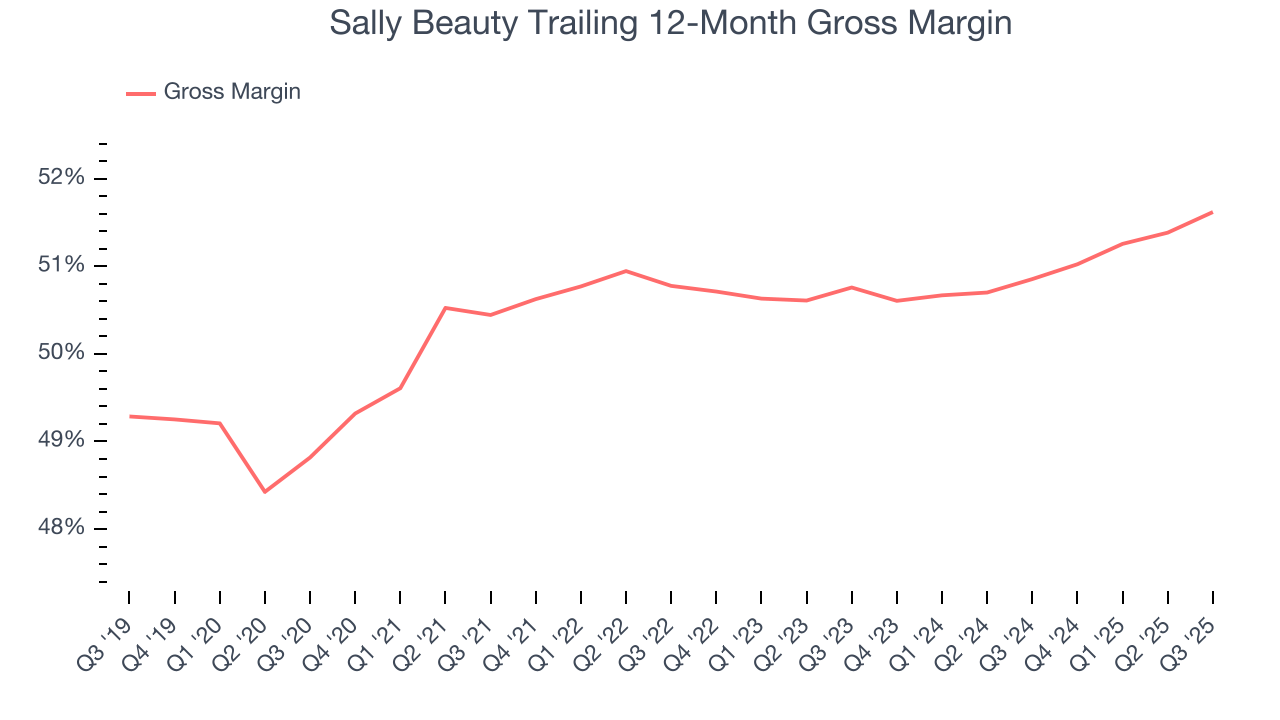
Sally Beauty produced a 52.2% gross profit margin in Q3, in line with the same quarter last year. Zooming out, the company’s full-year margin has remained steady over the past 12 months, suggesting it strives to keep prices low for customers and has stable input costs (such as labor and freight expenses to transport goods).
8. Operating Margin
Operating margin is an important measure of profitability for retailers as it accounts for all expenses necessary to run a store, including wages, inventory, rent, advertising, and other administrative costs.
Sally Beauty has done a decent job managing its cost base over the last two years. The company has produced an average operating margin of 8.2%, higher than the broader consumer retail sector.
Looking at the trend in its profitability, Sally Beauty’s operating margin rose by 1.2 percentage points over the last year, showing its efficiency has improved.
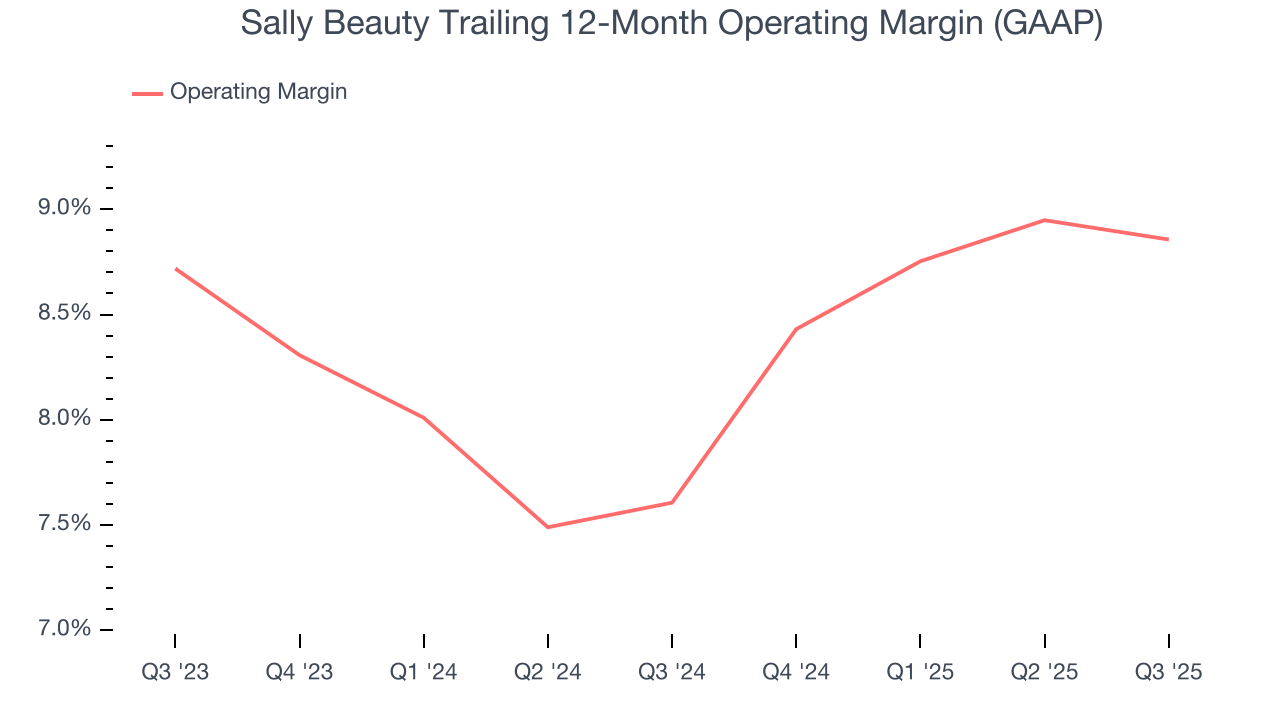
This quarter, Sally Beauty generated an operating margin profit margin of 8.4%, in line with the same quarter last year. This indicates the company’s cost structure has recently been stable.
9. Cash Is King
If you’ve followed StockStory for a while, you know we emphasize free cash flow. Why, you ask? We believe that in the end, cash is king, and you can’t use accounting profits to pay the bills.
Sally Beauty has shown impressive cash profitability, driven by its attractive business model that gives it the option to reinvest or return capital to investors. The company’s free cash flow margin averaged 4.3% over the last two years, better than the broader consumer retail sector.
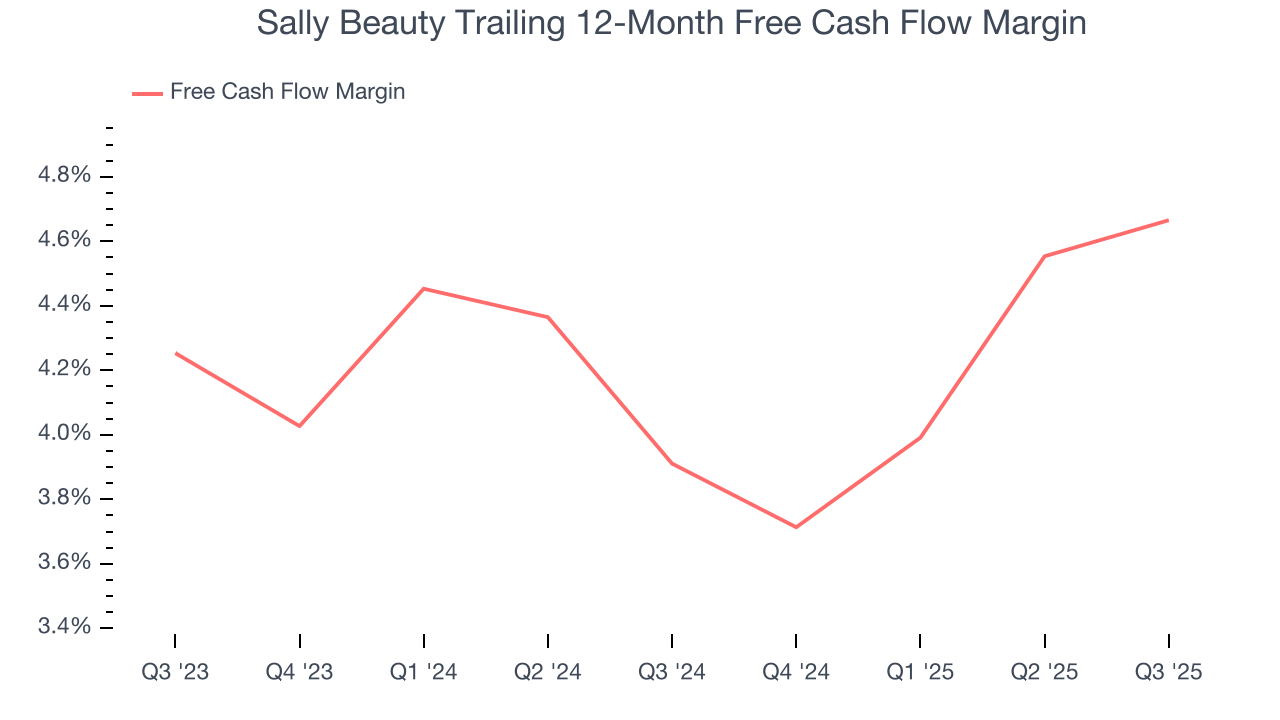
Sally Beauty’s free cash flow clocked in at $78 million in Q3, equivalent to a 8.2% margin. This cash profitability was in line with the comparable period last year and above its two-year average.
10. Return on Invested Capital (ROIC)
EPS and free cash flow tell us whether a company was profitable while growing its revenue. But was it capital-efficient? Enter ROIC, a metric showing how much operating profit a company generates relative to the money it has raised (debt and equity).
Sally Beauty historically did a mediocre job investing in profitable growth initiatives. Its five-year average ROIC was 12.6%, somewhat low compared to the best consumer retail companies that consistently pump out 25%+.
11. Balance Sheet Assessment
Sally Beauty reported $149.2 million of cash and $1.56 billion of debt on its balance sheet in the most recent quarter. As investors in high-quality companies, we primarily focus on two things: 1) that a company’s debt level isn’t too high and 2) that its interest payments are not excessively burdening the business.
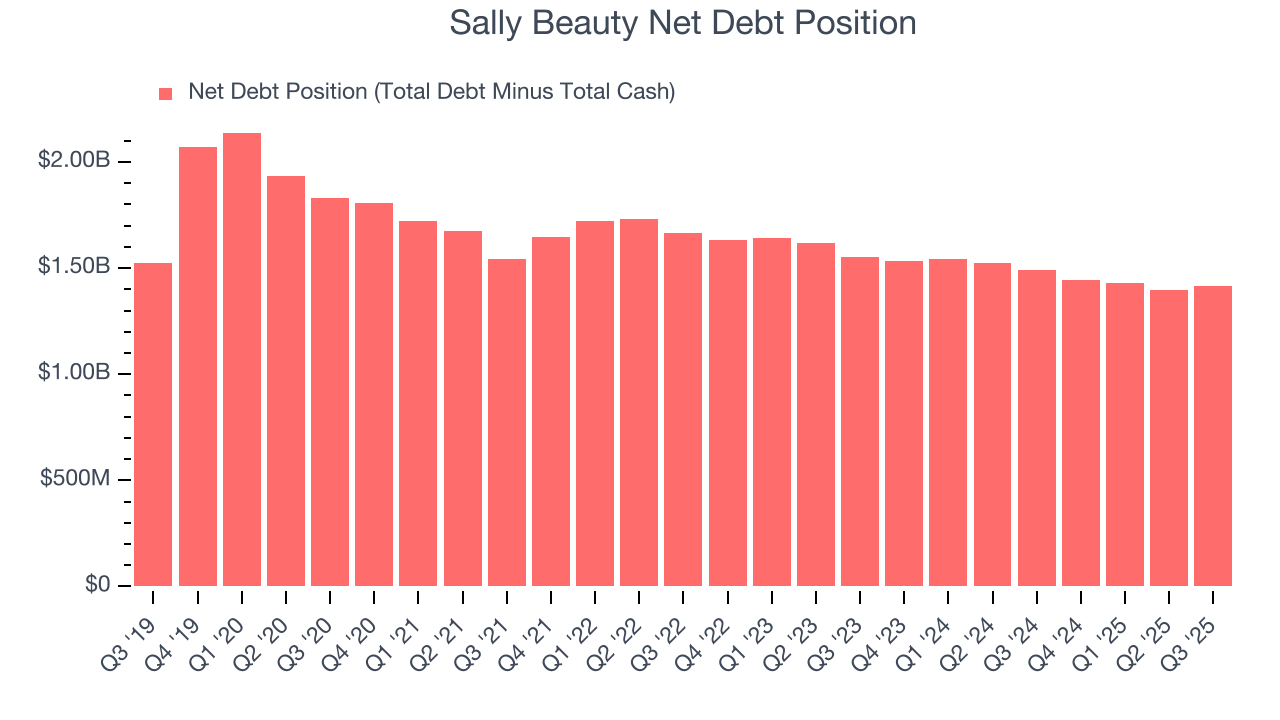
With $447.6 million of EBITDA over the last 12 months, we view Sally Beauty’s 3.2× net-debt-to-EBITDA ratio as safe. We also see its $34.49 million of annual interest expenses as appropriate. The company’s profits give it plenty of breathing room, allowing it to continue investing in growth initiatives.
12. Key Takeaways from Sally Beauty’s Q3 Results
We enjoyed seeing Sally Beauty beat analysts’ EBITDA expectations this quarter. We were also glad its EPS outperformed Wall Street’s estimates. Overall, we think this was a solid quarter with some key areas of upside. The stock traded up 1.7% to $14.94 immediately after reporting.
13. Is Now The Time To Buy Sally Beauty?
Updated: December 24, 2025 at 9:45 PM EST
Before making an investment decision, investors should account for Sally Beauty’s business fundamentals and valuation in addition to what happened in the latest quarter.
Sally Beauty doesn’t pass our quality test. First off, its revenue has declined over the last three years. And while its gross margins are a strong starting point for the overall profitability of the business, the downside is its brand caters to a niche market. On top of that, its low growth in new store openings show it’s focused on existing locations.
Sally Beauty’s P/E ratio based on the next 12 months is 7.3x. While this valuation is optically cheap, the potential downside is huge given its shaky fundamentals. There are better stocks to buy right now.
Wall Street analysts have a consensus one-year price target of $16.25 on the company (compared to the current share price of $15.16).





